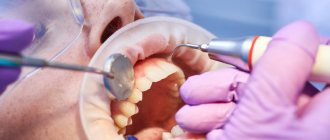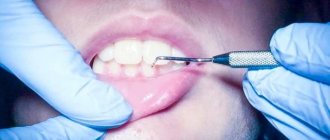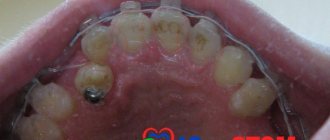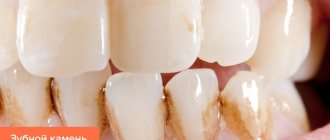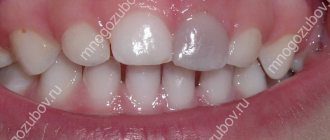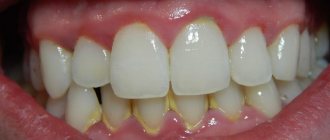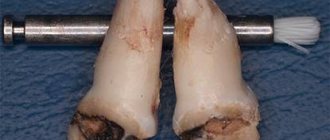Tartar formation and complications of this condition are one of the most common reasons for visiting a dentist. But not everyone knows that the appearance of this unaesthetic plaque can be prevented, and that prolonged absence of treatment for already formed stone can lead to tooth loss.
Experts diagnose almost all people with tartar, the treatment of which, as a rule, is quite expensive. To understand how you can avoid this problem, you need to understand what tartar is and how you can prevent its occurrence.
What is tartar
Tartar is hardened soft plaque. When brushing teeth incorrectly or poorly, a soft mass consisting of fragments of the mucosal epithelium, food particles and colonies of bacteria accumulates on their surface and in the interdental spaces. Under the influence of saliva and substances produced by bacteria, the mass gradually hardens, turning into tartar. Hard deposits may be observed on the back surfaces of teeth and between teeth, in which case they are classified as supragingival calculus. Gradually, under the influence of gravity and chewing movements, the stones move under the mucous membrane of the gums and are classified as subgingival.
How does plaque appear?
Dental plaque is formed in several stages:
- A soft bacterial plaque begins to settle on the enamel.
- If the oral cavity is not cleaned properly, plaque begins to harden within a few days.
- Then the plaque is mineralized, saturated with phosphorus and calcium, and cleaning teeth from such plaque becomes quite a difficult task.
How to choose toothpaste to fight plaque?
When purchasing anti-plaque toothpaste, you should pay attention to the following parameters of the product:
- RDA level.
The higher the number next to this inscription, the more abrasive particles there are in the toothpaste. If you need to remove hard plaque, you should select pastes with an index of more than 100 units. And those with sensitive enamel should not even try products with an indicator exceeding 70 units. - Fluorine and fluorides
are substances with very ambivalent benefits. Remember, their quantity must be standardized. In large doses, these compounds are toxic and can lead to enamel destruction. A safe amount of fluoride is no more than 0.6%. - Sodium lauryl sulfate (SLS)
often forms foam in toothpaste. Unfortunately, sodium lauryl sulfate is harmful to the body, and you should choose toothpastes that do not contain it. - Triclosan
is an antibiotic that is used to destroy pathogenic flora. However, along with the infection, beneficial bacteria are also killed, which negatively affects the acid balance in the mouth. It is better to buy pastes without this element. - Calcium carbonate
is an abrasive that, in addition to its beneficial effect, neutralizes the effect of fluorides.
In what cases does stone plaque form?
The reason for the formation of tartar is poor quality dental care, in which soft plaque is not completely removed. High mineral content causes plaque to harden. Using a too soft toothbrush, lack of attention to the interdental spaces and gum margins, irregular oral hygiene, etc. are the main sources of the problem.
But there are factors that increase the likelihood of hard deposits forming on teeth:
- diseases of the digestive system and endocrine system, in which the chemical composition of saliva changes;
- malocclusions and dental defects that form particularly difficult areas to clean;
- wearing dentures, braces, brackets, plates and other structures that make it difficult to properly clean teeth using a traditional brush and paste;
- a large amount of carbohydrate foods in the diet, which facilitates the gluing of soft plaque particles.
Kinds
Plaque is divided into two categories. First, supragingival stone appears, the cause of which is poor oral hygiene. Such deposits are located above the upper edge of the gingival crest, so they are easily diagnosed during a routine examination.
The characteristic features of supragingival tartar include:
- Localization on the inner surface of the tooth, from the side of the tongue;
- White or yellowish tint;
- The consistency is hard or clay-like.
The plaque is unstable, so it can be removed mechanically without any problems.
Subgingival calculus appears as a result of the fact that supragingival plaque descends down the root of the tooth and mineralizes. It forms in the gum pocket and is diagnosed only when using special dental instruments. Such deposits are considered age-related and most often appear in people over 40 years of age. If personal hygiene rules are not followed, it can appear at any age.
Signs of tartar:
- Dense and hard consistency;
- Light brown or greenish-black tint;
- Swelling and bleeding gums.
Symptoms of Tartar
The first symptoms of tartar are a change in the color of the enamel on the upper molars and lower incisors. Soft yellow or gray plaques appear. First of all, tartar forms in areas where there is no self-cleaning of the surface during the process of chewing food or rinsing: the interdental space, the inner walls of the tooth.
Primary symptoms:
- Bad breath;
- Mild itching of the gums;
- Slight bleeding.
If no measures are taken to remove plaque, it begins to mineralize, becoming harder. As a result, the gums may become inflamed and there will be severe swelling and redness. Detachment of the gingival margin is possible, which leads to the appearance of a periodontal canal.
What are the dangers of tartar?
In cases where tartar has already formed, treatment should be carried out immediately. Otherwise, it moves under the gums and leads to severe disorders of tissue metabolism in soft tissues.
As a result, acute or chronic gingivitis develops, the ligamentous apparatus of the tooth becomes inflamed and, as the most severe complication, periodontal disease develops - atrophy of the tissues that provide support to the tooth. As a result, a person who has developed subgingival tartar in the future faces the need to remove teeth that have lost stability and are no longer able to perform their functions.
Are there any risks?
Removing stone is a procedure that should become mandatory in the life of any person who cares about the health of their teeth. But if mandatory visits to the dental office are gradually becoming a habit for people, not much is known about stone removal.
Using a scaler is a safe procedure if the dentist knows how to use this device. The nozzle of the device constantly oscillates from top to bottom: to avoid damage to the enamel, it must be kept parallel to the tooth surface being treated.
If you have fillings, crowns or veneers, there are certain risks. A poorly placed filling can easily fall out under the influence of ultrasound; the same applies to low-quality cement used to fix crowns. You need to understand that it is poorly placed fillings that can fall out: if the filling of teeth was carried out in compliance with all standards, then ultrasound will not cause any harm.
The procedure for removing stones using ultrasound seems simple, but this is only an appearance. There may also be deposits under the gums, which require some effort to detect. Not every dentist will want to spend his time on this, since subgingival stones are not particularly visible to patients. However, it is these formations that pose the greatest danger, since they lead to the breakdown of tissue near the teeth, their loosening and subsequent loss. Subgingival deposits are largely to blame for the occurrence and development of inflammation in periodontal tissues.
Methods for treating tartar
Treating tartar on your own at home is not possible. Tartar removal is performed using practical and painless methods in the dentist’s office:
- Ultrasonic cleaning. This is the treatment of tartar with a scaler. The equipment generates low-frequency ultrasonic vibrations that destroy dental plaque. After this, the dentition is washed with a stream of water, and the enamel is ground and polished.
- Air Flow whitening system. In this case, cleaning is performed with an abrasive compound supplied under pressure through a special nozzle. The composition includes air, water and sodium carbonate. The equipment does an excellent job of cleaning the interdental space and effectively removes stubborn plaque.
- Laser cleaning. This is a non-contact technique that does not cause discomfort or pain. Tartar cleaning is performed with a directed laser beam, the remaining particles are washed out of the oral cavity with a water-air jet.
Pastes for removing plaque and polishing teeth –
To remove small tartar and pigmented plaque, we can use 2 groups of products. Firstly, there are some whitening toothpastes that are highly abrasive. The second option is that you can purchase a special paste for polishing teeth in a specialized store that sells consumables for dental clinics (this option is much more effective, and you can even place an order online).
The advantage of the first option is the high availability of whitening toothpastes (list below), but their capabilities will be much more modest when compared with professional polishing paste for removing plaque and plaque. Below we will talk in more detail about each option.
Detartrine Z polishing paste –
Professional polishing pastes “Detartrin” and “Detartrin Z” do an excellent job not only of smoker’s pigment plaque, but also even of small dental deposits. The second version of this paste is especially effective, containing specially sharpened zirconium granules that can remove dental plaque and smoker’s plaque without damaging the enamel (24stoma.ru). In addition, the paste contains essential oils, leaving a long-lasting feeling of freshness in the mouth. Production – (France).
Pastes “Detartrine” and “Detartrine Z” –
The paste is taken from the tube only with a clean spatula and applied to the bristles of the working head of the Oral-b brush. Next, you need to “spread” the paste over several teeth, then turn the brush on at low speed, and treat each tooth for 10-20 seconds (more precisely, as needed). After treating your teeth, you need to rinse your mouth thoroughly several times. Use no more than once a week. The cost of a 45 mg tube of “Detartrine Z” in different stores can range from 1,600 to 2,800 rubles.
There is also another version of this paste - the usual “Detartrine” without zircon. It is a little cheaper, but also copes somewhat worse with, for example, the smoker’s residue. But in any case, both versions of this paste are much more effective at removing pigmented plaque and dental plaque than most other similar products (i.e. similar polishing pastes from other manufacturers).
Toothpaste “PRESIDENT PROFI PLUS White Plus” –
controlled abrasiveness – RDA 200 ,- abrasive and polishing components (silicon dioxide, calcium carbonate, diatomaceous earth, titanium dioxide),
- applied only once a week,
- price 30 ml - about 260 rubles.
It is necessary to apply a small amount of paste to a group of several teeth, and then use the Oral-b toothbrush at low speed, for example, in the “Whitening / Polishing” or “For Sensitive Teeth” modes. The effectiveness of PRESIDENT White Plus will be lower than Detartrine Z.
Toothpaste “LACALUT White” –
controlled abrasiveness – RDA 120 ,- abrasive and polishing components (hydrated silicon dioxide and titanium dioxide),
- benefits – contains pyrophosphates and sodium fluoride,
- fluoride content: 1357 ppm,
- together with an electric brush can be used once every 2 days,
- price: 50 ml – from 250 rub., 75 ml – 350 rub.
The effectiveness of this paste will be significantly lower than the previous ones. And she can only help you with a small amount of not too pronounced pigmentation. Apply according to the same principle as previous products (together with an Oral-B electric brush).
A few additional recommendations -
The cost of a good Oral-B electric brush starts from 2700-3500 rubles (at this link you can read our review on the optimal choice of models). You can even buy “Detartrine Z” or “Detartrine” polishing paste in traditional online stores, but it will be cheaper to do it in those organizations that sell consumables for dental clinics. There are many such companies in every city. And I would like to say a few more words about the selection of toothpaste for daily use in the morning and evening.
It is advisable that in patients with a high rate of tartar formation, such a paste contains polydon or pyrophosphates (these components significantly reduce the rate of mineralization of soft microbial plaque and its transformation into hard tartar). Polyphosphates (for example, sodium hexametaphosphate and trisodium phosphate) can significantly reduce the adhesion and deposition of microbial plaque.
Another useful components are the proteolytic enzymes bromelain and papain. They help loosen the already formed tightly attached microbial plaque, which certainly contributes to its removal by the abrasive components of toothpastes. In addition, it is desirable to contain sodium fluoride or amino fluoride in the paste, and in a concentration of at least 1400 ppm. The fact is that fluoride has a bactericidal effect, suppressing the vital activity of microorganisms, thereby preventing an increase in the volume of microbial plaque in the oral cavity.
Well, in the next section we gave several examples of techniques that are recommended for removing tartar at home - on various thematic sites and forums. You might be interested in reading this nonsense.
How does an irrigator help with tartar?
One of the most frequently asked questions about whether an irrigator removes tartar can be answered this way: the irrigator helps with the prevention of tartar. It can only help if deposits have just begun to form and they have not yet formed stone. Regular and thorough brushing with a toothbrush and toothpaste, flossing, and completing your oral care with a irrigator can greatly reduce the risk of tartar.
But even in this case, tartar cleaning should be completed in the dentist’s office: the doctor will grind the enamel to eliminate roughness that facilitates the formation of plaque.
Tartar: how to get rid of it at home
Most people understand that the best way to resolve any dental problems is to visit the dentist. However, not everyone likes to contact a specialist, delaying the visit until the last minute in the hope that the problem will somehow resolve itself. This is largely facilitated by advertising offering treatment for all occasions.
So how to remove tartar at home? Unfortunately, no way. Even the most expensive products will not be able to remove thick plaque and stone. However, ultrasonic or electric brushes, as well as special toothpastes, will help get rid of the soft plaque that is just beginning to form.
Prevention of tartar formation
The only reliable and effective means of prevention is control over the quality and regularity of dental and gum care.
Be sure to brush your teeth at least 2 times a day (morning and evening), ending each procedure with the use of an irrigator. This will help remove soft plaque from areas that traditional oral hygiene products cannot reach.
In addition, it is important to monitor your overall health, promptly seek bite correction and minimize the consumption of fast carbohydrates such as baked goods, sweets, etc.
More detailed information is presented in the catalog of oral irrigators.
